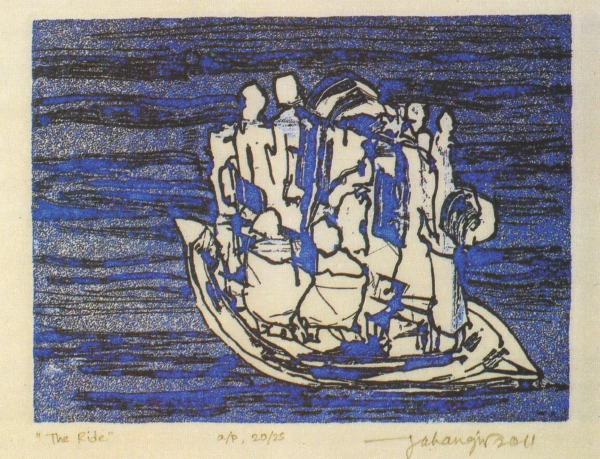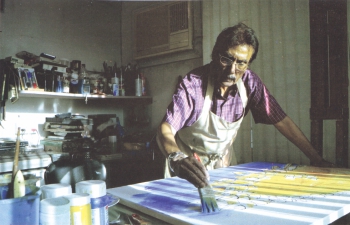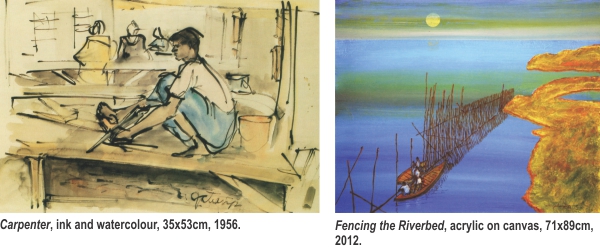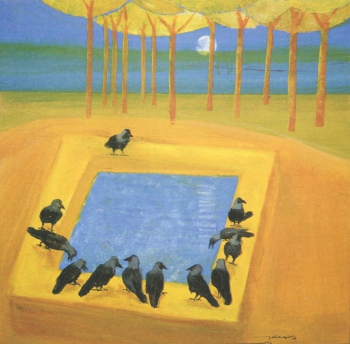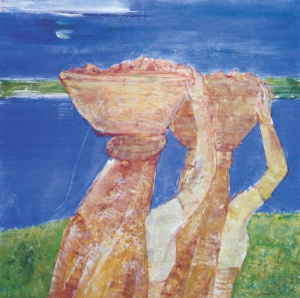| Home - Back Issues - The Team - Contact Us |
 |
| Volume 11 |Issue 44| November 09, 2012 | |
|
|
Achievement
Syed Jahangir's Relationship with Nature Fayza Haq As always Syed Jahangir's work is washed in gold and blue. Once again, at a 12-day exhibition at Bengal Gallery celebrating his 80th birthday, he works on nature, and mankind's hope in the future, with the help of nature. He presents woman as constantly working and as important as the man — as she does waste time chatting or smoking. The river and sky is often brought into his canvas and paper. Boats, fishermen, farmers and women with children, to take care of, are the subjects of his theme. His past, when he was a child, in the villages, is important for him. In Khulna he passed a contented time, and his nostalgic memories play an important part in his delineation of nature. The people are active, contented, and look forward to the future.
Jahangir was asked by his teachers in the USA, to stay on, and inspect what went on in Europe, as in Germany, France, and England. He had travelled to the Far East, going to China and Japan, in order to broaden his horizons. He had been to all parts of the Subcontinent. But he wanted to remain in Bangladesh where he got his inspiration. He enjoyed Rankin Street, and parts of Old Dhaka. He was intrigued by the way the Hindus did their “Puja” every month-with colour, food and fanfare. He loved playing kites on the roofs. For him, the two Eids tended to be stereotyped. There was no Banani, or Gulshan or Dhanmandi in his days, as he puts it. But the Art College of Dhaka under Zainul Abedin, Shafiuddinn Ahmed, Mohammed Kibria, and the younger ones like Monirul Islam, did exist. He enjoyed the company of Shubier Chowdhury, in his younger days. Qayyum Chowdhury and Burhanuddin Jehangir who spoke on the inaugural evening were his beloved peers. They took pride in knowing him, as an artist nonpareil, who could fill the galleries of Bengal with acrylic and oil painting work. Some early crayon work, were also included in order to give the true retrospective. He is equally at home doing figurative work and his near abstractions. His drawing is also marvellous and admirable. In all his works, he deals with the miracle of the villages, which intrigue him, and inspire him to work on whether it be in acrylic or with oil paints. Even his portrayal of crows drinking water, or a woman sheltering a child are thought- provoking. The artist depicts man in various activities that bring him in touch with nature - fishing and harvesting. “Nature is an integral part of life. Without nature, there is no life, for man. From my youth nature has been an integral part of my life, and it egged me on to do amazing things. In Khulna ( Satkhira) we had to walk for two miles to reach school and so we were well-acquainted with nature. With harvest came the cutting of paddy. Sixty-five years ago life was restful there, was not the 21st century hurry and scurry. I wanted to stand still and paint the beautiful details of nature, and its manifold bounties. I wanted to leave out the ugliness of modern civilisation as we see ourselves after the colonisation of the developing world by the more powerful countries of the west."
“They come to our country, saying they will help build railways, bridges, buildings and what have you. In the process they destroy the green effect of Nature. There is the marring of the environment with sound and smoke pollution, jarring our sensibilities. There is hardly a place that we can call a leisure park. Rivers are being covered with silt and man-made rubbish. We agonise at the destruction of the beauty and simplicity of Nature. But we do little to change this,” says the 80- year-old artist, who appears half his age with his charm and ability to be engaged in everyday repartee.
“Charcoal was intriguing, and I used it often on the walls of the houses, which appeared like some big canvas to me. Simple lines represented the flying kites, which intrigued me no end," remarks Jahangir. In the beginning he was a realist when he sketched his cousin, and presented other human figures in his early days as an artist. Later his art became more complex and simplification set in, along with abstraction. He did not go into simple stylised series of art where each piece appears to be a part and parcel of a larger painting. Each and every work at the exhibition is complete by itself. In "Towards Destiny" in acrylic— the sky, river and elements within Nature, become one concrete whole. This includes the trees and houses as well as the human beings, who are found in the folds of Nature. In many of his paintings one finds waiting boats. Golden, yellow and blue are the colours the artist has chosen repeatedly. The woman waiting, sitting on a boat go hand in hand with the other depictions of man working within nature with elements like land, water and the sky. Apart from people and houses, paths lined with leafy trees, giving way to people, going about their work — are not left out. The artist's images are clear and easy to comprehend. There is little that is confusing. Like his peers, Qayyum Chowdhury, and Murtaja Baseer, his work is clear cut, and more or less easy to follow. So what made Syed Jahangir choose to be an artist instead of a banker, lawyer or doctor? Syed Jahangir says that his brother, Sikandar Abu Jaffer, who was a journalist, egged him on to be a success at the Dhaka Art College, under Zainul Abeden, and his pioneer peers, who wished to bring fine arts to the Muslims of East Bengal (Bangladesh). He brought out “Shamakal”, and recognised the artist's inclination in painting. His brother, who came from Kolkata, had joined the Radio in Dhaka. Abu Jaffer knew Zainul Abedin. Qamrul Hasssan and Safiuddin Ahmed. These senior artists helped Syed Jahangir obtain all the formal education that he needed, including Art History and drawing of perspectives.
These foreign experts were, as Syed Jahangir puts it, keen in sending the young artists overseas to Europe and the USA to learn from galleries. At that time, many decades back, there was not the neck and neck competition, as there is today. Thus the young artist went on a Fellowship for three months. This was in 1958, and he went to 22 states, culling as much knowledge as he could. For him, the New York and Guggenheim Museums were the roots of learning. He spent about a month more in England, Italy and France to broaden his horizons. The exhibition ends on November 13.
|
||||||||||||
Copyright
(R) thedailystar.net 2012 |
